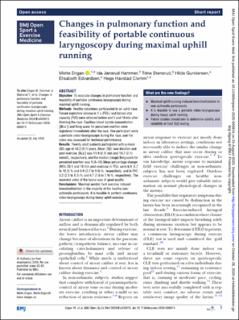| dc.contributor.author | Engan, Mette | |
| dc.contributor.author | Jansrud, Ida | |
| dc.contributor.author | Stensrud, Trine | |
| dc.contributor.author | Gundersen, Hilde | |
| dc.contributor.author | Edvardsen, Elisabeth | |
| dc.contributor.author | Clemm, Hege Havstad | |
| dc.date.accessioned | 2021-02-01T10:23:56Z | |
| dc.date.available | 2021-02-01T10:23:56Z | |
| dc.date.created | 2020-09-23T14:44:15Z | |
| dc.date.issued | 2020 | |
| dc.identifier.citation | BMJ Open sport & exercise medicine. 2020, 6(1), Artikkel e000815. | en_US |
| dc.identifier.issn | 2055-7647 | |
| dc.identifier.uri | https://hdl.handle.net/11250/2725514 | |
| dc.description | This is an open access article distributed in accordance with the Creative Commons Attribution 4.0 Unported (CC BY 4.0) license, which permits others to copy, redistribute, remix, transform and build upon this work for any purpose, provided the original work is properly cited, a link to the licence is given, and indication of whether changes were made. See: https://creativecommons.org/licenses/by/4.0/. | en_US |
| dc.description.abstract | Objective To evaluate changes in pulmonary function and feasibility of portable continuous laryngoscopy during maximal uphill running.
Methods Healthy volunteers participated in an uphill race. Forced expiratory volume in 1 s (FEV1) and forced vital capacity (FVC) were obtained before and 5 and 10 min after finishing the race. Capillary blood lactate concentration ([BLa-]) and Borg score for perceived exertion were registered immediately after the race. One participant wore a portable video-laryngoscope during the race, and the video was assessed for technical performance.
Results Twenty adult subjects participated with a mean (SD) age of 40.2 (9.7) years. Mean (SD) race duration and post-exercise [BLa-] was 13.9 (2.3) min and 10.7 (2.1) mmol/L, respectively, and the median (range) Borg score for perceived exertion was 9 (5–10).
Mean percentage change (95% CI) 5 and 10 min post-exercise in FEV1 were 6.9 (3.7 to 10.2) % and 5.9 (2.7 to 9.0) %, respectively, and in FVC 5.2 (2.3 to 8.1) % and 4.7 (1.6 to 7.9) %, respectively. The recorded video of the larynx was of good quality.
Conclusions Maximal aerobic field exercise induced bronchodilatation in the majority of the healthy non-asthmatic participants. It is feasible to perform continuous video-laryngoscopy during heavy uphill exercise. | en_US |
| dc.language.iso | eng | en_US |
| dc.title | Changes in pulmonary function and feasibility of portable continuous laryngoscopy during maximal uphill running | en_US |
| dc.type | Peer reviewed | en_US |
| dc.type | Journal article | en_US |
| dc.description.version | publishedVersion | en_US |
| dc.rights.holder | © Author(s) (or their employer(s)) 2020 | en_US |
| dc.source.pagenumber | 1-6 | en_US |
| dc.source.volume | 6:e000815 | en_US |
| dc.source.journal | BMJ Open sport & exercise medicine | en_US |
| dc.source.issue | 1 | en_US |
| dc.identifier.doi | 10.1136/bmjsem-2020-000815 | |
| dc.identifier.cristin | 1832632 | |
| dc.description.localcode | Institutt for idrettsmedisinske fag / Department of Sports Medicine | en_US |
| cristin.ispublished | true | |
| cristin.fulltext | original | |
| cristin.qualitycode | 1 | |
